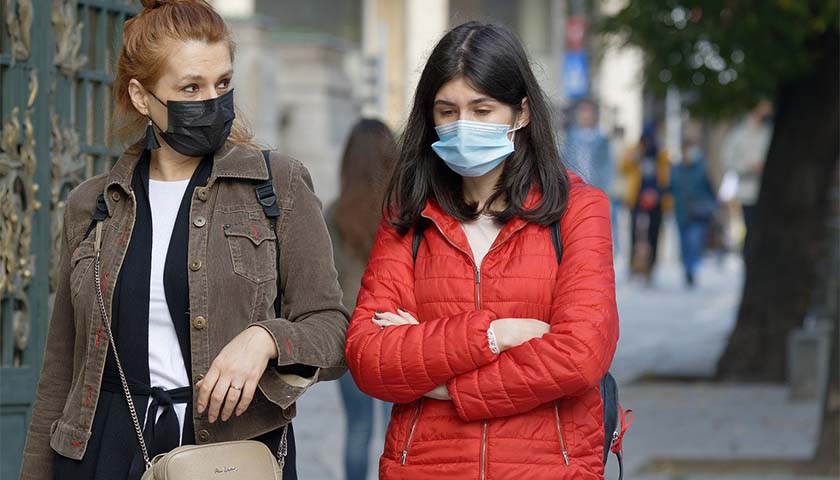by Josh Hammer
The recent arrival of the Omicron variant of COVID-19 has, for far too many, reset the clock of our timeline for a return to societal normalcy.
Public health authorities in many countries reimposed loosened travel restrictions that had lapsed. Washington, D.C., under the mayorship of Muriel Bowser, passed a draconian private-sector vaccination mandate, the likes of which had previously only passed muster in iconic deep-blue metropolises such as New York City. The vacillating mandarins who constitute the “public health” apparatus in this country, such as Lord-Emperor Anthony Fauci, quickly began fearmongering about the need to avoid large gatherings for Christmas and New Year’s Eve. Restaurants and bars across the country that had shelved mask mandates suddenly deemed it necessary to make customers mask up again.
The sober reality, as should be obvious as we approach the two-year anniversary of “15 Days to Slow the Spread,” is that COVID-19 is simply not going anywhere; much like influenza or the common cold, it is now something humanity is simply going to have to deal with. Furthermore, at this point in the “pandemic,” it should be equally obvious that the COVID-19 vaccines are completely ineffective at preventing viral transmission. There is simply no compelling evidence that the vaccines are generally effective at slowing the spread. The vaccines often appear to be an effective symptom mitigation prophylactic for those who catch COVID-19, but that makes vaccination a quintessential private health decision with little-to-no relevance for public health authorities.
The Omicron variant, furthermore, may be highly contagious, but it is also highly nonlethal. According to a Wednesday tweet from no less a public health “authority” than Centers for Disease Control and Prevention Director Rochelle Walensky herself, the Omicron variant, compared with its delta variant predecessor, poses a 53% percent lower risk for symptomatic hospitalization, a 74% percent lower risk for ICU admission and a 91% percent lower risk of death. What’s more, zero— — yes, literally (SET ITAL) zero (END ITAL)— — oOmicron-infected patients in the United States.S. have, to date, required mechanical ventilation. And it is at best unclear, as of this writing, whether there has been more than (SET ITAL) one (END ITAL) Omicron-induced death in the United States..S.
What’s more, Oomicron isn’t just symptomatically mild— — it’s everywhere. Last week, the CDC estimated that a remarkably high 95.4% percent of new COVID-19 cases in the United States.S. were attributable to Omicron.
In such a situation as this, where the overwhelming majority of new cases for a highly contagious virus (and for which even a “booster” vaccine cannot help forestall transmission) are so symptomatically mild and where the possibility of death is near zero, there is only one logical public policy posture that public health authorities should take: Sit back and let the Omicron variant rip through these United States.
Suffice it to say that this has not been our universal response to date. As popular pundit Ann Coulter tweeted last month, the D.C.- and blue state-driven reaction has often looked more like this: “GOD: Here’s a gift humans: a COVID variant that’s wildly contagious, but not lethal, to spread immunity far and wide! HUMANS (in blue states): TRIPLE MASK! CANCEL GATHERINGS! SHUT DOWN!”
Coulter’s instinct is sound. In general, it is imprudent to base sweeping public policy decisions on idiosyncratically vulnerable population subsets. As one example, consider how no one in his right mind would seek to ban peanuts despite the fact that a peanut allergy is both common and often deadly (certainly, far deadlier than Omicron). This has been the biggest flaw in our COVID-19 response, all along: It always made more sense to isolate and quarantine the uniquely compromised, rather than impose in blunderbuss fashion draconian restrictions upon an entire populace.
The very nonlethal nature of Omicron only further militates in favor of a policy of “let it rip.” Zero Americans have required a ventilation from Omicron to date, and it seems that precisely one American has died. It borders on insanity to make public policy based on that. The wiser and saner thing to do would be to let the Omicron variant rip and spread far and wide, temporarily making many Americans mildly ill in the short term while bulking up their natural immunity in the long term—and, of course, avoiding ventilation and death.
To that end, public policy should actually look like something approximating the opposite of our current approach. Instead of doling out free COVID-19 tests willy-nilly and encouraging everyone to test and avoid one another, we should be discouraging mass testing—especially for the asymptomatic—and eschewing any and all arbitrary restrictions on public gatherings. Leading red states such as Texas, Florida and Tennessee can and should lead the way by restricting the mass availability of testing for all but the vulnerable and immunocompromised. On Omicron, the freest policies are now necessarily also the best policies.
At least as it pertains to the Omicron variant, the only way out is through. Let this thing rip.
COPYRIGHT 2022 CREATORS.COM
– – –
Josh Hammer is the opinion editor of Newsweek. A popular conservative commentator, he is a research fellow with the Edmund Burke Foundation and a syndicated columnist through Creators. A frequent pundit and essayist on political, legal, and cultural issues, Hammer is a constitutional attorney by training. He is a former John Marshall Fellow with the Claremont Institute and a campus speaker through Intercollegiate Studies Institute, Young America’s Foundation, and the Federalist Society.
Photo “Women in Masks” by Surprising_Shots.






The common cold is an infection of the upper respiratory tract which can be caused by many different viruses. The most commonly implicated is a rhinovirus (30–80%), a type of picornavirus with 99 known serotypes.[30] Other commonly implicated viruses include human coronaviruses (≈ 15%),[31][32] influenza viruses (10–15%),[33][34][35] adenoviruses (5%),[33] human respiratory syncytial virus (RSV), enteroviruses other than rhinoviruses, human parainfluenza viruses, and human metapneumovirus.[36] Frequently more than one virus is present.[37] In total, more than 200 viral types are associated with colds.[4]
An AP fear-porn article today is titled something like “Hospital ICU bed capacity reaches 83% in the U.S.” – More manipulation tactics of the lay public by the media – what most people don’t know is that ICUs typically run at about 85% capacity all the time, under normal circumstances. Hospitals are not going to loose money on empty ICUs.